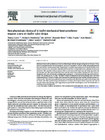Non-physiologic closing of bi-leaflet mechanical heart prostheses requires a new tri-leaflet valve design
dc.contributor.author
Carrel, Thierry
dc.contributor.author
Dembitsky, Walter P.
dc.contributor.author
de Mol, Bas
dc.contributor.author
Obrist, Dominik
dc.contributor.author
Dreyfus, Gilles
dc.contributor.author
Meuris, Bart
dc.contributor.author
Vennemann, Bernhard
dc.contributor.author
Lapeyre, Didier
dc.contributor.author
Schaff, Hartzell
dc.date.accessioned
2020-03-20T10:33:46Z
dc.date.available
2020-03-20T02:28:59Z
dc.date.available
2020-03-20T10:33:46Z
dc.date.issued
2020-04-01
dc.identifier.issn
0167-5273
dc.identifier.other
10.1016/j.ijcard.2020.01.056
en_US
dc.identifier.uri
http://hdl.handle.net/20.500.11850/405818
dc.identifier.doi
10.3929/ethz-b-000405818
dc.description.abstract
Mechanical heart valve prostheses are based on older designs without changes during the last 40 years. Today, there is an unmet need for less thrombogenic mechanical prostheses. Analysis of the relationship between flow characteristics and thromboembolic complications is possible using numerical and biomolecular flow studies that have shown that the reverse rather than the forward flow is responsible for local platelet activation and thrombosis. After peak flow, leaflets experience flow deceleration and the leaflets are still widely open when the flow becomes zero. The closure of the valve starts with the onset of reverse flow. Therefore, the valve closes extremely fast with most of the leaflet traveling angle occurring in <10 ms with excessively high reverse flow velocities. The pivoting spaces, so-called “Hot Spots” should be eliminated to prevent pathologic shear stress that result in thrombosis. A novel tri-leaflet valve combines favorable hemodynamics with the durability of mechanical heart valve. This valve closes within 60 ms, much slower than bi-leaflet valves and similar to the closing mode of a tissue valve. Micro-particle image velocimetry did not show critical regions of flow stagnation and zones of excessive shear in the pivoting region suggesting low potential for thrombogenic events that should allow to avoid long-term anticoagulation.
en_US
dc.format
application/pdf
en_US
dc.language.iso
en
en_US
dc.publisher
Elsevier
en_US
dc.rights.uri
http://creativecommons.org/licenses/by-nc-nd/4.0/
dc.subject
Cardiac valve
en_US
dc.subject
Thrombosis
en_US
dc.subject
Anticoagulation
en_US
dc.subject
Design
en_US
dc.title
Non-physiologic closing of bi-leaflet mechanical heart prostheses requires a new tri-leaflet valve design
en_US
dc.type
Journal Article
dc.rights.license
Creative Commons Attribution-NonCommercial-NoDerivatives 4.0 International
dc.date.published
2020-01-23
ethz.journal.title
International Journal of Cardiology
ethz.journal.volume
304
en_US
ethz.journal.abbreviated
Int J Cardiol
ethz.pages.start
125
en_US
ethz.pages.end
127
en_US
ethz.version.deposit
publishedVersion
en_US
ethz.identifier.wos
ethz.identifier.scopus
ethz.publication.place
Amsterdam
en_US
ethz.publication.status
published
en_US
ethz.date.deposited
2020-03-20T02:29:14Z
ethz.source
SCOPUS
ethz.eth
yes
en_US
ethz.availability
Open access
en_US
ethz.rosetta.installDate
2020-03-20T10:33:59Z
ethz.rosetta.lastUpdated
2021-02-15T09:12:28Z
ethz.rosetta.versionExported
true
ethz.COinS
ctx_ver=Z39.88-2004&rft_val_fmt=info:ofi/fmt:kev:mtx:journal&rft.atitle=Non-physiologic%20closing%20of%20bi-leaflet%20mechanical%20heart%20prostheses%20requires%20a%20new%20tri-leaflet%20valve%20design&rft.jtitle=International%20Journal%20of%20Cardiology&rft.date=2020-04-01&rft.volume=304&rft.spage=125&rft.epage=127&rft.issn=0167-5273&rft.au=Carrel,%20Thierry&Dembitsky,%20Walter%20P.&de%20Mol,%20Bas&Obrist,%20Dominik&Dreyfus,%20Gilles&rft.genre=article&rft_id=info:doi/10.1016/j.ijcard.2020.01.056&
Files in this item
Publication type
-
Journal Article [128795]

